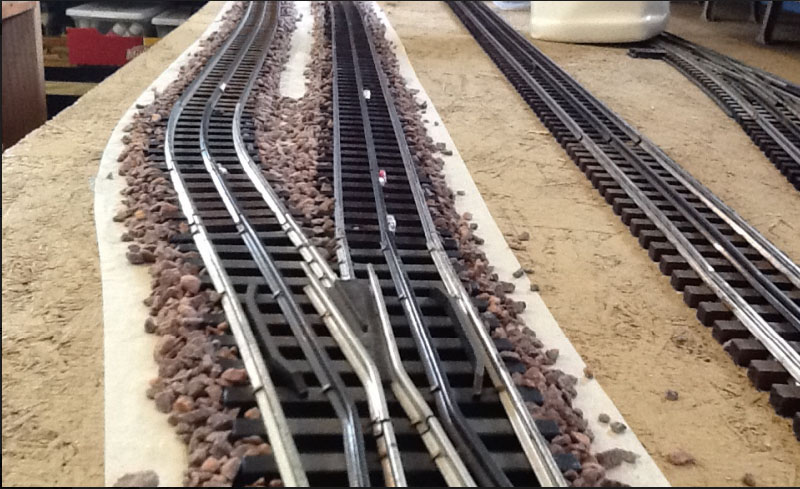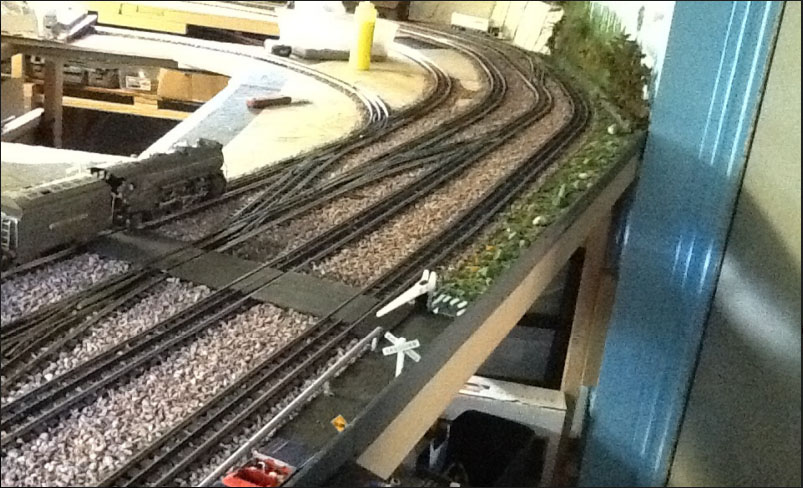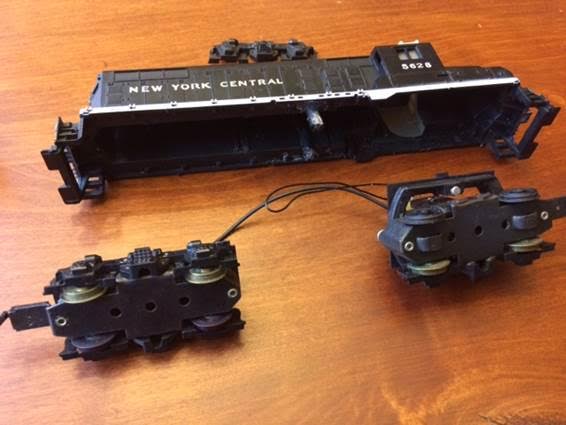“Hi Al,
just short video as a carry on from last weeks showing a change to that siding as was pointed out it ran too close to the main line, also I have moved some track on the other side, now we have a smoother run to the curve, and I have now added a couple of Peco points motors, the side mounted ones which is a cheap and easy way to add powered motors to your points (turnouts )
May be of some help to modellers wanting to add points motors the easy way.
Regards
Dave”
Latest ebay cheat sheet is here.
“Al –
Duane had commented on ballast and I use chicken grit on an O scale railroad. Larger and I believe more realistic then the finely ground Woodland Scenics or using shingle grit. A 25 pound bag is less the $15 at a feed supply store. I have about 700 linear feet of track and used less the 4 bags.
Some pictures are attached.
Ernest”
“Hi Al,
I retired a few years ago and want to set up a model railroad for my grandson. In the mid-sixties I had a small HO layout that I boxed up and have not used since then. I unpacked the box around Christmas and discovered the engine won’t run. The engine was made by TYCO and I don’t know if it’s worth trying to repair. I took the shell off and there’s no obvious way to lubricate it. Any suggestion would be appreciated.
Thanks,
John”
A huge thank you to Dave for another helpful vid – I have no idea how he finds the time. If you’re new to the site, Dave is a member of the Hall of Fame, and also cast his eye of the Beginner’s Guide and gave it the thumbs up.
That’s all this time folks. Please do keep ’em coming.
Best
Al





Thank you Dave for another fine video.
Thank you Ernest. I see that you are another O size layout. I too have used the chicken grit on a hollow core door layout for my granddaughter, now taken over by her younger brother. Simple circle with two turnouts from back to far side. I added strips to the side to increase width of door to increase the oval. Since both sides are panel, I glued 1/2″ foam board on top and made groves under track to hide all control wiring. Then after track is laid, ballast placed with diluted white glue holds track and hides wire trough. A 1X3 inch board was secured around door edges to protect foam and other items. She was young when built, so put rain gutter brackets on four corners and then simply cut plastic gutter proper length for table height. Easy to change height later.
Bruce in SC USA
The grit too big don’t look rite
Hi John….Use it for display in junk or repair area on the layout you build…You can get engines and cars brand new and very cheap on ebay….Good luck with it and you sound like a great “granpa”….Mike
Why don’t you do a bloopers video, those are always fun.
John, if the train has been sitting for as long as you said then it is not worth it to fix and there is no way to lubricate it because it is all enclosed. I have a few older Tyco and Bachmann trains that don’t work so I used it in a train yard because it is unfixable.
great stuff again Dave
keep em runnin fellas
stjohn in long beach calif
John
Now is a good time to take that old train apart and learn a little about how they work. You can’t make it worse than it is, and maby you can fix it. Try turning the motor by hand or jump wire the motor directly to the transformer. You have nothing to lose and a lot to learn. Have fun
Steve from Toms River
try using some WD-40, it can’t make it worse and in any case will help to clean things up and dissolve the old lube. It will leave a dry lube film that will protect surfaces from wear and from corrosion. Can’t hurt to try.
Dave
I always enjoy watching your videos. You have an exceptionally gooed layout and your videos are well produced.
John in San Diego, California.
I have to agree, the chicken grit is too large for even O gauge. I might be ok for G gauge.
Can’t see from the pic what sort of motor is in the Tyco loco, but common problems we find when people bring non-functioning locos to our open days are:
Wheels dirty.
Pickup contacts dirty or bent away from wheel, or pushed sideways shorting out to uninsulated part of wheel.
Lead from pickup pulled off or “dry” solder joint not passing current.
Motor power tag bent round, or the bared end of power lead, touching motor frame.
Metal debris picked up by magnet (eg track pin) shorting or jamming the drive.
Brushes dirty or not touching commutator, or brush spring(s) loose/missing.
On metal bodied locos, live parts such as tyres touching eg inside of wheel arches, shorting through body.
Rod
Oops, should add to the list, commutator slots full of carbon, shorting between the poles, or damage to the fine wire forming the motor windings.
Rod
Great video from Dave…
The Chicken Grit does look big but if it looks right to your eyes…
It is your railroad… The coarse Woodland Scenics does look too fine and I would need to see the shingle grit… A mix of shingle grit and Chicken Grit might be perfect….
As to the Tyco engine… Try the WD 40…
The way they powered those locomotives really was not that good… Old AHM/Rivarrossi models of the same era came from the factory “Ready to Repower”…
Bachmann was a little better in that era but it too had its issues…
Would suggest going to e-bay (use Al’s link/cheater) and looking for older Athearn…Should be in the $25 to $50 range and are “bullet proof” when it comes to reliability.
Sometimes the comments or suggestions are very valuable.
The layout is beautiful
Ernest
I hate to say it but the chicken grit is to big and the color is off. With a big layout it takes a lot of ballast. I used to have saltwater fish and used calcium for the gravel. It is an off white color but is the perfect size and shape. I mixed in some watered down gray acrilic paint until I got thr right look. Make big batches so the color is consistent. I went to a real railroad track and took a rock. that is my color match. Play with it and have fun
Steve from Toms River
great video Dave I struggle just doing my layout let alone trying to make a video as well, must admit after working in the shed doing my guitars model boats and scenery on my layout to watch your videos really relaxes me thanks
Duane I don’t do ballasting even DD doesn’t enjoy it. it does look a bit large but I am no expert I love photos the track work looks great. John I take mine to the local repair hobby shop they give me a price and its yes or no It cost me a lot to get my very first train I bought 10 years ago to work I reckon it was worth it.
I use a fine sieve (usually used for flour) to get my grit down to a more realistic size but I think that in real life grades from 1 inch to 6 inches were and are used internationally.
Ernest,
I agree that the ballast looks a bit large and off color. Use your imagination and some paint and some greenery to make it appear more realistic. Remember, it is your world and if appeals to you go for it. Model railroading is meant to add enjoyment to your life, not anxiety. Experiment, make mistakes and learn, but most of all have fun! Cheers! NJ Mark
anything is worth fixing if all you got is time.
sound like a little wD 40 .
Ya just need to get things moving
Interesting ideas. Dave is great as always.
The size of the chicken grit does seem a bit too large for O scale. I suggest an even cheaper alternative. It’s crushed/shredded walnut shells. These come in 25/50 pound bags. That’s more than almost anyone should ever need. They are light weight, non-magnetic and cheap. They also come in three different sizes. The smallest are suitable for HO scale. You can find them in paint stores. They are used by normal people to add texture to their walls by mixing them with their wall paint. The sole drawback with the walnut shells is that they are a dark brown color, and depending on your prototype need to be painted a ballast color either before or after adding them to your track as ballast. Their saving grace is that they do take paint easily. It is important to check the color and size of your desired real railroads ballast. Interestingly, the UP/Santa Fe in California uses a locally available reddish brown stone as ballast throughout much of their desert areas.
I had several tyco engines that I brought back to life. Once you have looked them over and made sure all the wires are still attached, try a few drops of Kano’s Kroil (you can find it on the internet if you can’t find it locally) near the ends of the motor and any gears or wheel hubs you can see. Let it sit for an hour or so as the oil will creep into tiny nooks and crannies–be careful not to use too much…I am talking about eye dropper amounts. Once it has sat, try to see if you are able to move the wheels at all–if you can, wipe off any excess and try applying some power on a section of test track that you know is operational.
Good luck and let us know if you are successful.
Not sure WD-40 is a good idea. I would use Contact Cleaner spray, then sewing machine oil. Try not to get any oil on the commutator.
Here’s an idea for gauging ballast grain size. If you have a figure in that scale hold a piece of your intended ballast against it. If the ballast grain is as big as the figure’s head then you know it’s too big. Fit in the figure’s hand? Then it’s close enough.